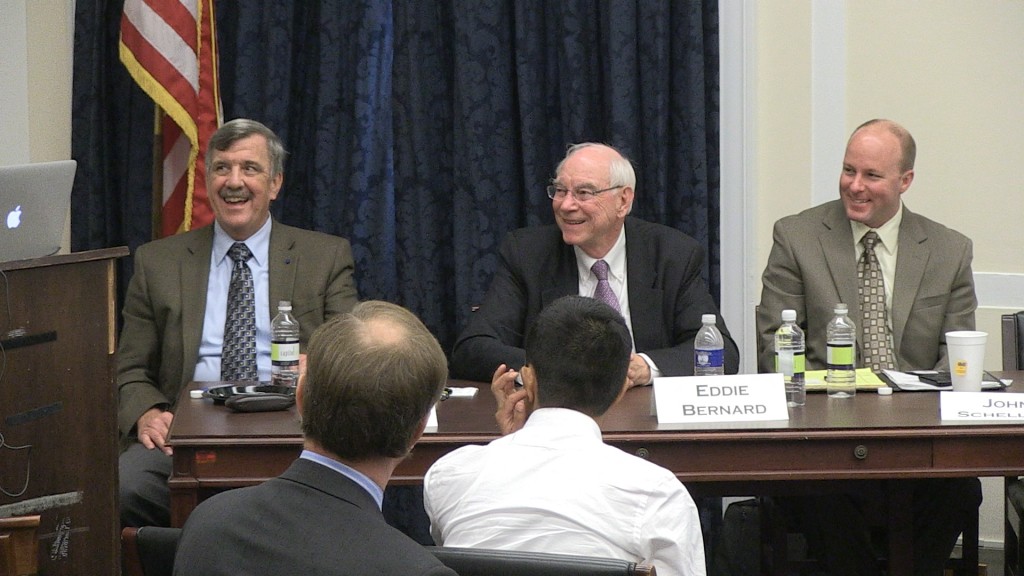23 March 2012
Tsunami preparedness briefing on Capitol Hill stresses disaster education
Posted by kramsayer

Scientists discuss lessons learned from the March 11, 2011 tsunami in Japan at a congressional briefing sponsored by the American Geophysical Union. (Credit: AGU)
A year after the tsunami that devastated the Japanese coastline, the United States still needs to ramp up its tsunami preparedness, experts say.
Scientists at a March 21 Capitol Hill briefing in Washington, D.C., stressed the importance of detecting tsunamis before they reach coastlines and educating the public on tsunami dangers. The briefing was held for members of Congress and their staffers.
Eddie Bernard, director of NOAA’s Pacific Marine Environmental Laboratory (PMEL) in Seattle, Wash., spoke to the need for early detection in order to save lives. One way of keeping an eye out for tsunamis is a buoy system called Deep-ocean Assessment and Reporting of Tsunamis (DART), Bernard said. The buoys, deployed in regions with a history of tsunamis, detect seismic waves and send the information via satellite to researchers.
The laboratory developed and deployed the first DART buoy off the coast of Oregon in 1995. Fifty-seven buoys will be deployed in total by the end of this year. The United States owns 40 and Australia, Chile, Indonesia, Thailand, Russia, and India own a combined total of 14. Japan agreed to purchase three buoys following last year’s tsunami. The system has become an international effort, Bernard said, and the buoys now ring most of the Pacific Ocean. Up-to-date information on wave heights is given for most buoys on the DART website.
“The bonus here is [the buoys] are all standard. Everybody can use other people’s data,” he explained. “That’s part of the international cooperation that I think is so important.”
The next step for the buoys might be relocation, Bernard said. Currently, the buoys sit about 20 minutes away from tsunami source areas, meaning there is about a 20-minute delay before wave height information is relayed to researchers. A shorter distance would mean shorter warning times, and potentially more lives saved.
But detection is only one step in tsunami preparedness.
“Detection and forecasting alone don’t save lives and property,” said John Orcutt, professor of geophysics at Scripps Institution of Oceanography in La Jolla, Calif., and another speaker at the briefing, sponsored by the American Geophysical Union and several other organizations.
“It didn’t help in Japan a great deal.”
What did help, Orcutt said, were proper risk assessments of potential flooding and damage and education programs about tsunami threats and evacuation procedures. It’s a lesson that should be applied in the United States, he added.
“This is one of the most crucial parts for preparedness in the United States – not necessarily the advances in technology – but actually investing in learning,” Orcutt said.
One area of high tsunami risk for the United States and Canada is the stretch of coastline in the Pacific Northwest that includes Northern California, Oregon, Washington, and British Columbia. Just offshore is a major fault called the Cascadia Subduction Zone, which scientists estimate could produce earthquakes of magnitude 9 or greater and could result in a potentially devastating tsunami.
Tsunami education leads to decreased panic and more efficient evacuation, said John Schelling, the earthquake and tsunami program manager for the Washington State Emergency Management Division and another briefing speaker. Thanks to a tsunami education program, plus warnings from DART, Washington State officials were able to evacuate only specific communities in danger after the Japanese earthquake – as opposed to calling for mass evacuations of the coast, the program manager said.
“Because our local responders had trained, and our communities had practiced, people were able to get to safety with no issues,” Schelling said.
With locally-triggered tsunamis, such as ones that could originate just off the Washington coast, there might only be a five-minute warning before the waves hit shore, he said. This renders early warning systems ineffective and makes education all the more important.
“There’s no warning system on…this Earth that’s going to get people any type of warning in that amount of time,” he said. “The only thing that’s going to save lives in these events is if people understand where they are in relation to high ground, and know the appropriate action to take.”
Education of the general public is not an easy task, Schelling acknowledged, especially when a large portion of the United States’ population does not live in a tsunami-prone area. But even those people occasionally visit, he said. Lessons learned from tsunami education could also be applied to any flooding situation, even those caused by heavy rains or hurricanes, Schelling added.
“There is no one flyer, no one commercial that’s going to reach all of these audiences,” he said. “They all have to be engaged individually, and they have to be approached with something that shows what’s in it for them.”
Eric Villard, AGU science writing intern


 GeoSpace is a blog on Earth and space science, managed by AGU’s Public Information staff. The blog features posts by AGU writers and guest contributors on all sorts of relevant science topics, but with a focus on new research and geo and space sciences-related stories that are currently in the news.
GeoSpace is a blog on Earth and space science, managed by AGU’s Public Information staff. The blog features posts by AGU writers and guest contributors on all sorts of relevant science topics, but with a focus on new research and geo and space sciences-related stories that are currently in the news.
This is a great article. Preparing for disaster or any event that can take away our routine and supplies is something we should all do and take seriously. Please continue to educate and post. Thank you.